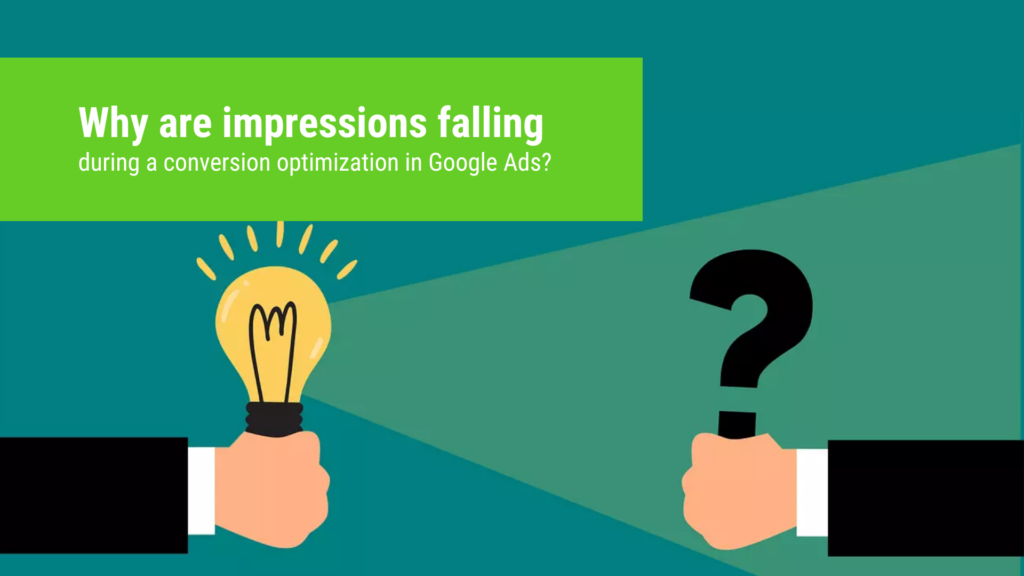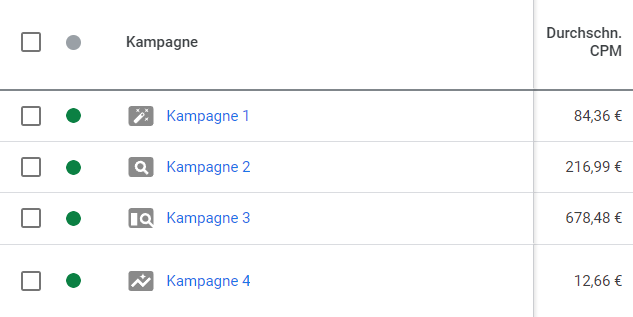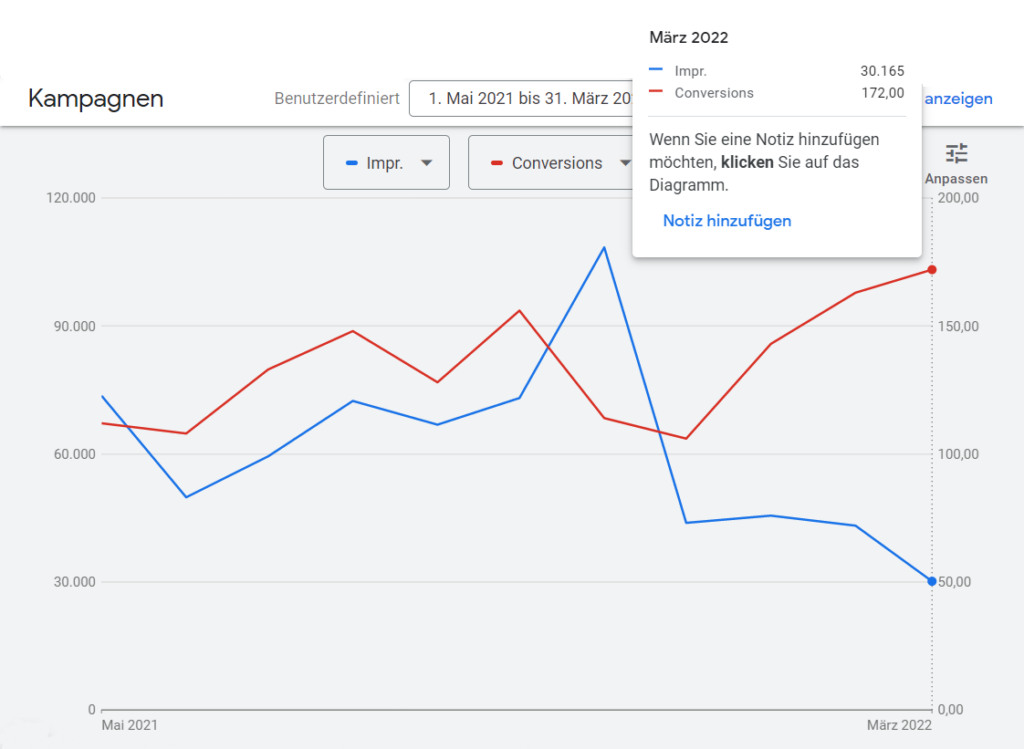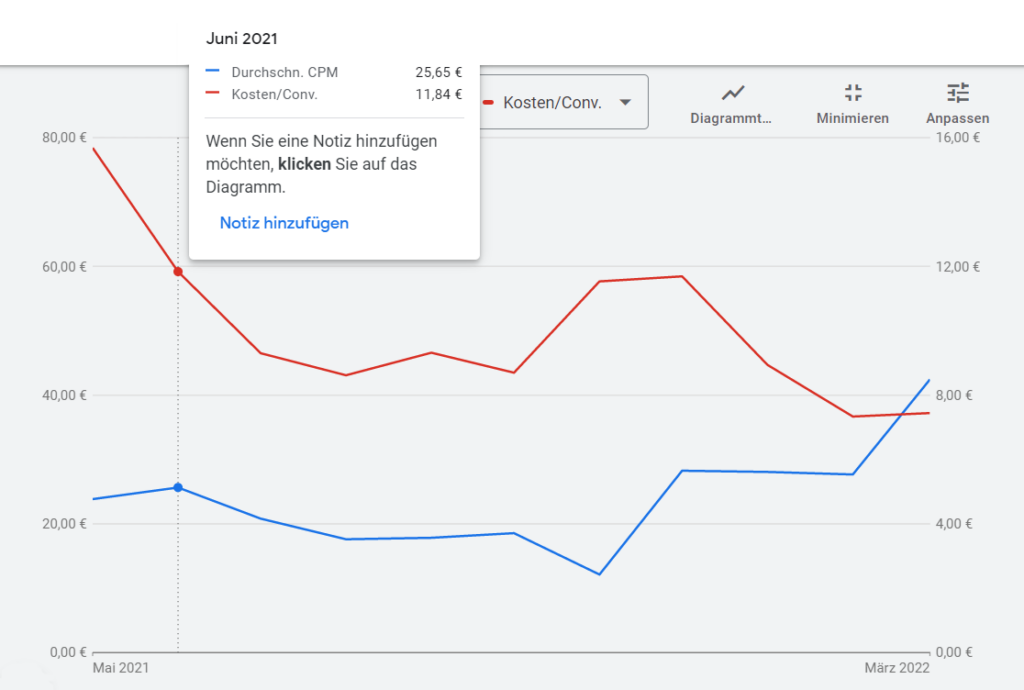Impressions decreasing in Google Ads during a conversion optimization?

Many people wonder why Google Ads campaign impressions decrease when more conversions are generated from the same budget. That’s because high-converting, in-market audiences often have higher CPMs, which means fewer impressions are generated.
The idea that the total number of impressions is a central and decisive indicator for a performance measurement is still widespread. At first glance, this seems logical, because the more impressions an ad has, the higher the probability of generating clicks, purchases and inquiries – so the assumption. In fact, in reality it is not so, which is simply due to the fact that different campaign types and different target groups – have different CPM (CPM = cost point per 1,000 impressions). A search network campaign on Google Ads can have an average CPM of €50, while for a highly targeted and highly valuable audience the CPM can be well over €200. A display campaign, on the other hand, can have a CPM of €2 – €3, which means that we can generate over 1,000,000 impressions for as little as €2,000. The trick is that on high-priced topics, a search network campaign with high CPM can have a cost per lead of €20-€80 because the users have a search intent – while the cost per lead of a display campaign is which is located in push marketing, can be around 200€ – 300€ with good optimization. Often the CPL (cost per lead) for display campaigns is even higher than 200€ – 300€, while the impressions are extremely cheap. So we see:The total number of impressions in itself and in raw terms is not meaningful in this form.

Varying CPM depending on campaign, keywords and audience targeting. So there is no such thing as “the impressions”, rather the booked impressions have fundamentally different values and qualities.
Conversion Optimization with Smart Bidding: Deliver to likely-converting audiences with higher CPM
As far as lead generation is concerned, it is not the total number of impressions that matters, but the high quality of the impressions. For us, this means that it is not about any impressions, but rather very specific impressions that are beneficial for the business.
But there is another factor: When using smart bidding strategies ( maximize conversions or maximize conversion value ), the algorithm itself searches for the users who are most likely to convert and who are most willing to buy. As soon as one of these users has converted, the system searches for other similar users. Audiences who are likely to convert tend to have a higher than average CPM because many competitors are bidding on them either manually or using smart bidding as well.
Over time, the following phenomenon can now arise: As part of a conversion optimization, fewer redundant impressions are generated, but impressions are generated for the target groups most likely to convert – which in turn have higher CPMs because they are very competitive. This will generate more deals and more conversions from the same budget. At the same time, this reduces the total number of impressions, because fewer impressions are delivered that are cheap but redundant and contain wastage. Instead, the budget is used for impressions that are expensive but likely to convert.

Campaign with Smart Bidding bid strategy Maximize conversions over time while staying the same budget. Impressions fell sharply while conversions rose sharply. The reason: fewer but more expensive impressions will be delivered to the users who are most likely to buy and convert – this increases the number of conversions. Redundant, wasteful and cheaper impressions are delivered less.
There are two primary causes of higher CPMs
In summary, we can say that there can be two main reasons for an above-average CPM: Delivery of the impressions to particularly valuable and conversion-probable target groups and complex targeting configurations themselves. Other reasons for the increase could be, for example, a low ad quality or page quality of the landing page, for which the system can increase the CPM a little.
Higher CPM with complex targeting configuration
The more specific a targeting is, the higher the CPM. This applies, for example, to target groups with a total size that is far below the minimum recommended by the advertising system (for LinkedIn Ads, this would be 15,000 users in a target group). In particular, it applies to nested conditions for targeting alignment: The more conditions the advertising system has to meet in order to find precisely these complex, nested users, the more expensive it becomes. That is why the pure target group orientation in the Google Ads search network – at least in German-speaking countries – is very expensive compared to booking a target group on observation. Here it can be that a normal campaign CPM without target group targeting is 50€, but with target group targeting it is a good 700€. So it costs a lot if you want the advertising system to fulfill the condition that you only reach users from target group X if they have entered the very specific keyword Y. Therefore, funnel stage transitions do not work as linearly as one would hope for in Google Ads. When users clicked an ad and the next adshould only be aimed at the people who have clicked before, the CPM is usually so high that it is not worth fiddling with. If this results in a conversion, it is usually completely overpriced and has a normal lead quality. From this point of view, normal target group monitoring with smart bidding would have been more effective.
Higher CPM for valuable and likely to convert audiences
Valuable audiences have higher CPM than average because they are either highly likely to convert and ready to buy, or there is a lot of competition for them. If many competitors are bidding on a keyword, resulting in a high click price, the impressions behind this keyword are correspondingly more expensive in the CPM. If competitors book very specific target groups in targeting, such as homeowners in the real estate industry, and book high bid adjustments in order to deliver impressions to exactly these people – Smart Bidding will also automatically display your own ad to target groups with higher CPM if they are likely to convert get ranked.

The conversions become cheaper over time (red line: cost per conversion) while the CPM becomes more expensive. With a lower cost per conversion, more conversions are generated from the same budget – i.e. more leads. So even though a lead cost less, the CPM was more expensive because valuable and likely-to-convert audiences are getting the impressions.
Share of possible impressions and so-called missed impressions
Another point that causes a lot of confusion in marketing executives is the impression share and the so-called lost impressions. Impression share is the percentage of our impressions that are served, based on budget spent, location targeting service area, keywords, and match types.
This means that if we book more keywords, the pool of maximum possible impressions is also larger and the proportion of possible impressions decreases. However, this also means that switching from phrase-match keywords to broad-match keywords greatly increases this pool. Now there are people who use a declining proportion of possible impressions as a basis for argument in order to outline a downward trend or a starting point for optimization potential to less tech-savvy marketing management levels. In fact, impression share is just the piece of the pie bought with the current budget. That would be like when we want to buy a piece of cake from the baker and he tells us: You only have a 10% share of possible cakes, give me ten times the budget, and you will get from me all available slices of cake. And that only affects one campaign – i.e. one cake – of several. If we have 20-30 campaigns, there are “more” shares available for each one.
This is exactly where the lost impressions come into play, which show you what market share we could still achieve with additional budget. This might be helpful for possible scaling, but is used by some to say that “impressions are lost”. That would be similar to when we buy a loaf of bread from the baker and the baker says: You lose 98% of the goods to the competition and you “lose” goods that you never had to your competition. “There is an urgent need for action here”.
Conclusion: Impressions are different
Ultimately, impressions are delivered to people who are different, have different interests, and different willingness to buy. And just as people are different, the fit of the impressions is also different, and thus the impressions in their usefulness as well. A few expensive impressions to a few users who are very likely to buy can have a cost per lead of €20 – €80 for high-priced topics. On the other hand, 1,000,000 Display Network impressions for €2,000 can generate maybe 3 leads that are of low lead quality. In other words, the total number of impressions is not meaningful by itself and in its raw form, because the likelihood of conversion, willingness to buy, target groups and CPM of the impressions vary greatly.
Impressions are falling and conversions are rising?
If you have any questions regarding this blog article, feel free to ask:
Ask your question
info@slavawagner.de
Overview
You might also be interested in:
Youtube SEO with TubeBuddy and Ahrefs: Optimize descriptions, titles and tags
Keywords with search volume data are not only available for organic Google searches, but also for YouTube keywords.
Data scraping with Data Miner browser extension: Analyze social media channels
Data Miner is a browser extension that can scrape data from website interfaces.

